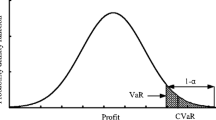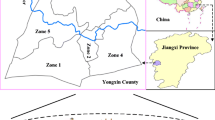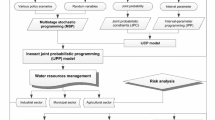Abstract
Water quality management along rivers involves making water-allocation plans, establishing water quality goals, and controlling pollutant discharges, which is complicated itself but further challenged by existence of uncertainties. In this study, an inexact two-stage stochastic downside risk-aversion programming (ITSDP) model is developed for supporting regional water resources allocation and water quality management problems under uncertainties. The ITSDP method is a hybrid of interval-parameter programming, two-stage stochastic programming, and downside risk measure to tackle uncertainties described in terms of interval values and probability distributions. A water quality simulation model was provided for reflecting the relationship between the water resources allocation, wastewater discharge, and environmental responses. The proposed approach was applied to a hypothetical case for a shared stream water quality management with one municipal, three industrial and two agricultural sectors. A number of scenarios corresponding to different river inflows and risk levels were examined. The results demonstrated that the model could effectively communicate the interval-format and random uncertainties, and risk-aversion into optimization process, and generate a trade-off between the system economy and stability. They could be helpful for seeking cost-effective management strategies under uncertainties, and gaining an in-depth insight into the water quality management system characteristics, and make cost-effective decisions.









Similar content being viewed by others
Abbreviations
- t :
-
Planning horizon; t = 1 for period 1, t = 2 for period 2
- i :
-
Water users; i = 1 for municipal, i = 2 for food processing plant, i = 3 for thermal power plant, and i = 4 for paper mill
- r :
-
Agricultural sector; r = 1 for agricultural region I, and r = 2 for agricultural region II
- j :
-
Type of crops; j = 1 for cotton, j = 2 for rice, j = 3 for maize, j = 4 for soybean, j = 5 for peanut, j = 6 for wheat, and j = 7 for rape
- h :
-
Stream inflow level; h = 1 for low level, h = 2 for medium level, and h = 3 for high level
- n :
-
Agricultural pollutants; n = 1 for total nitrogen (TN), n = 2 for total phosphorus (TP)
- m :
-
River pollutants; m = 1 for BOD, m = 2 for COD
- \( W_{it}^{ \pm } \) :
-
Allocation target of water that is promised to user i (106 m3)
- \( DW_{iht}^{ \pm } \) :
-
Amount of water deficit in scenario h during period t (106 m3)
- \( NB_{it}^{ \pm } \) :
-
Net benefit of user i per unit of water allocated (million$/106 m3)
- \( CS_{it}^{ \pm } \) :
-
Reduction of net benefit to user i per unit of water not delivered during period t (million$/106 m3)
- \( CT_{it}^{ \pm } \) :
-
Costs of wastewater treatment of user i during period t (million$/106 m3)
- \( \varphi_{it}^{ \pm } \) :
-
Wastewater emissions of per water consumption during period t
- p ht :
-
Probability of occurrence for scenario h during period t
- \( S_{jrt}^{ \pm } \) :
-
Surface water irrigation target of crop j in agricultural region r (ha)
- \( SD_{jrht}^{ \pm } \) :
-
Area by which surface water irrigation target \( S_{jrt}^{ \pm } \) is not met under inflow h (ha)
- \( CA_{jt}^{ \pm } \) :
-
Reduction of net benefit of crop j per unit of yields during period t ($/kg)
- \( BC_{jt}^{ \pm } \) :
-
Net benefit of crop j per unit of yields ($/kg)
- \( Y_{j}^{ \pm } \) :
-
Crop yields (kg/ha)
- \( CF_{n}^{ \pm } \) :
-
Cost of fertilizer n ($/kg)
- \( FD_{jnt}^{ \pm } \) :
-
Fertilizer application amount of crop j during period t (kg/ha)
- x 1, x 2, x 3, x 4, x 5, x 6, x 7, x 8 and x 9 :
-
Length of reach 1, 2, 3, 4, 5, 6, 7, 8 and 9, with the value of 2.2, 3.6, 3.2, 2.5, 3.5, 2.5, 2.0, 2.8 and 3.2 km, respectively
- \( S_{jrt\hbox{max} }^{ \pm } \) :
-
Maximum allowable plant area for crop j (ha)
- \( R_{1m}^{ \pm } ,\;R_{2m}^{ \pm } ,\;R_{3m}^{ \pm } ,\;R_{4m}^{ \pm } ,\;R_{5m}^{ \pm } ,\;R_{6m}^{ \pm } ,\,R_{7m}^{ \pm } ,\,R_{8m}^{ \pm } \,{\text{and}}\,R_{9m}^{ \pm } \) :
-
Designated pollutant (m) concentration at the beginning of 1, 2, 3, 4, 5, 6, 7, 8 and 9, respectively (mg/L)
- \( B_{jnt}^{ \pm } \) :
-
Demand of fertilizer n during the whole plant growing period (kg/ha)
- \( TN_{jnt}^{ \pm } \) :
-
Maximum loss tolerance of fertilizer n of each crop in period t (kg/ha)
- \( \zeta_{jt}^{ \pm } \) :
-
Irrigation quota for crop j (103 m3/ha)
- \( q_{ht}^{ \pm } \) :
-
Available water resources in scenario h during period t (106 m3)
- \( W_{it\hbox{max} }^{ \pm } \) :
-
Maximum allowable allocation amount for user i during period t (106 m3)
- \( C_{imt}^{ \pm } \) :
-
Concentration of pollutant m in raw wastewater generated at source i in period t (mg/L)
- \( \eta_{imt}^{ \pm } \) :
-
Pollutant treatment efficiency at source i during period t (%)
- \( GB_{im}^{ \pm } \) :
-
Pollutant concentration of wastewater discharge in emission standard of sewage (mg/L)
- \( C_{0m} \) :
-
Pollutant concentration at the head of reach 1 (mg/L)
- \( \varepsilon_{jnt}^{ \pm } \) :
-
Volatilization loss of fertilizer n during the whole plant growing period (%)
- \( Q_{ht}^{ \pm } \) :
-
Stream inflow in scenario h during period t (106 m3)
- v :
-
Average flow velocity (5.5 km/day)
- λ :
-
A control factor to acquire a more stringent limitation of risk, λ ∈ [0, 1]
- \( \Omega_{it}^{ \pm } ,\,\Omega_{rt}^{ \pm } \text{ } \) :
-
Expected benefit of municipal, industrial and agricultural sectors
- \( \psi_{it}^{ \pm } ,\,\psi_{rt}^{ \pm } \) :
-
Expected downside risk value
- A r :
-
Agricultural acreage of region r (ha)
References
Aseeri A, Bagajewicz MJ (2004) New measures and procedures to manage financial risk with applications to the planning of gas commercialization in Asia. Comput Chem Eng 28:2791–2821
Bean JC, Higle JL, Smith RL (1992) Capacity expansion under stochastic demands. Oper Res 40(2):210–216
Birge JR, Louveaux FV (1988) A multicut algorithm for two-stage stochastic linear programs. Eur J Oper Res 34:384–392
Birge JR, Louveaux FV (1997) Introduction to stochastic programming. Springer, New York
Cai YP, Huang GH, Wang X, Li GC, Tan Q (2011) An inexact programming approach for supporting ecologically sustainable water supply with the consideration of uncertain water demand by ecosystems. Stoch Environ Res Risk Assess 25:721–735
Cheng L, Subrahmanian E, Westerberg AW (2003) Design and planning under uncertainty: issues on problem formulation and solution. Comput Chem Eng 27(6):781–801
Ferrero RW, Riviera JF, Shahidehpour SM (1998) A dynamic programming two-stage algorithm for long-term hydrothermal scheduling of multireservoir systems. Trans Power Syst 13(4):1534–1540
Finger R (2013) Expand ing risk consideration in integrated models—the role of downside risk aversion in irrigation decisions. Environ Model Softw 43:169–172
Guo P, Huang GH, Zhu H, Wang XL (2010) A two-stage programming approach for water resources management under randomness and fuzziness. Environ Model Softw 25:1573–1581
Huang GH (1996) IPWM: an interval parameter water quality management model. Eng Optim 26:79–103
Huang GH (1998) A hybrid inexact-stochastic water management model. Eur J Oper Res 107:137–158
Huang GH, Chang NB (2003) Perspectives of environmental informatics and systems analysis. J Environ Inform 1(1):1–6
Huang GH, Loucks DP (2000) An inexact two stage stochastic programming model for water resources management under uncertainty. Civ Eng Environ Syst 17:95–118
Huang GH, Baetz BW, Patry GG (1992) An interval linear programming approach for municipal solid waste management planning under uncertainty. Civ Eng Environ Syst 9:319–335
Kovacs L, Boros E, Inotay F (1986) A two-stage approach for large-scale sewer systems design with application to the Lake Balaton resort area. Eur J Oper Res 23(2):169–178
Lee CH, Chang SP (2005) Interactive fuzzy optimization for an economic and environmental balance in a river system. Water Res 39:221–231
Li YP, Huang GH (2009) Two-stage planning for sustainable water-quality management under uncertainty. J Environ Manag 90:2402–2413
Li YP, Huang GH, Nie SL (2006) An interval-parameter multi-stage stochastic programming model for water resources management under uncertainty. Adv Water Resour 29:776–789
Li YP, Huang GH, Nie SL (2007) Mixed interval-fuzzy two-stage integer programming and its application to flood-diversion planning. Eng Optim 39(2):163–183
Li W, Li YP, Li CH, Huang GH (2010) An inexact two-stage water management model for planning agricultural irrigation under uncertainty. Agric Water Manag 97:1905–1914
Li T, Li P, Chen B, Hu M, Zhang XF (2013a) A simulation-based inexact two-stage chance constraint quadratic programming for sustainable water quality management under dual uncertainties. ASCE J Water Resour Plan Manag (Am Soc Civ Eng). doi:10.1061/(ASCE)WR.1943-5452.0000328
Li Z, Huang GH, Zhang YM, Li YP (2013b) Inexact two-stage stochastic credibility constrained programming for water quality management. Resour Conserv Recycl 73:122–132
Lohani BN, Thanh NC (1978) Stochastic programming-model for water-quality management in a river. J Water Pollut Control Fed 50:2175–2182
Loucks DP, Stedinger JR, Haith DA (1981) Water resource systems planning and analysis. Prentice-Hall, Englewood Cliffs
Lustig IJ, Mulvey JM, Carpenter TJ (1991) Formulating two-stage stochastic programs for interior point methods. Oper Res 39:757–770
Lv Y, Huang GH, Li YP, Sun W (2012) Managing water resources system in a mixed inexact environment using superiority and inferiority measures. Stoch Environ Res Risk Assess 26(5):681–693
Maeda S, Kawachi T, Unami K, Takeuchi J, Izumi T, Chono S (2009) Fuzzy optimization model for integrated management of total nitrogen loads from distributed point and nonpoint sources in watershed. Paddy Water Environ 7:163–175
Mance E (2007) An inexact two-stage water quality management model for the river basin in Yongxin County. University of Regina, Regina
Maqsood I, Huang GH, Huang YF, Chen B (2005) ITOM: an interval-parameter two-stage optimization model for stochastic planning of water resources systems. Stoch Environ Res Risk Assess 19:125–133
Matthies M, Berlekamp J, Lautenbach S, Graf N, Reimer S (2006) System analysis of water quality management for the Elbe River basin. Environ Model Softw 21(9):1309–1318
Mobasheri F, Harboe RC (1970) A two-stage optimization model for design of a multipurpose reservoir. Water Resour Res 6(1):22–31
Nikoo MR, Kerachian R, Karimi A (2012) A nonlinear interval model for water and waste load allocation in river basins. Water Resour Manag 26:2911–2926
Niksokhan MH, Kerachian R, Amin P (2009) A stochastic conflict resolution model for trading pollutant discharge permits in river systems. Environ Monit Assess 154(1):219–232
O’Connor DJ, Dobbins WE (1958) Mechanisms of reaeration in natural streams. Trans Am Soc Civ Eng 123:641–684
Qin XS, Huang GH, Zeng GM, Chakma A, Huang YF (2007) An interval-parameter fuzzy nonlinear optimization model for stream water quality management under uncertainty. Eur J Oper Res 180:1331–1357
Qin XS, Huang GH, Chen B, Zhang BY (2009) An interval-parameter waste-load-allocation model for river water quality management under uncertainty. Environ Manag 43:999–1012
Sasikumar K, Mujumdar PP (2000) Application of fuzzy probability in water quality management of a river system. Int J Syst Sci 31(5):575–591
Sortino FA, Lee NP (1994) Performance measurement in a downside risk framework. J Invest 3(3):59–64
Thomann RV, Mueller JA (1987) Principles of surface water quality modeling and control. Harper and Row, New York
Victoria FB, Viegas Filho JS, Pereira LS, Teixeira JL, Lanna AE (2005) Multi-scale modeling for water resources planning and management in rural basins. Agric Water Manag 77:4–20
William OD, Carolina O, Christian P, Marta S, José LD (2013) Water quality analysis in rivers with non-parametric probability distributions and fuzzy inference systems: application to the Cauca River, Colombia. Environ Int 52:17–28
Xie YL, Li YP, Huang GH, Li YF, Chen LR (2011) An inexact chance-constrained programming model for water quality management in Binhai New Area of Tianjin, China. Sci Total Environ 409:1757–1773
Xie YL, Huang GH, Li W, Li JB, Li YF (2013) An inexact two-stage stochastic programming model for water resources management in Nansihu Lake Basin, China. J Environ Manag 127:188–205
Xu Y, Huang GH, Qin XS (2009) Inexact two-stage stochastic robust optimization model for water resources management under uncertainty. Environ Eng Sci 26:1765–1776
Yeomans JS, Gunalay Y (2009) Using simulation optimization techniques for water resources planning. J Appl Oper Res 1(1):2–14
Yu ZW (2002) Spatial energy market risk analysis part I: an introduction to downside risk measures. In: Proceedings of IEEE Power Engineering Society Winter Meeting, vol 1, 27–31 January, pp 28–32
Zarghami M, Szidarovszky F (2009) Stochastic-fuzzy multi criteria decision making for robust water resources management. Stoch Environ Res Risk Assess 23:329–339
Zheng Y, Keller AA (2007) Uncertainty assessment in watershed-scale water quality modeling and management: 1. Framework and application of Generalized Likelihood Uncertainty Estimation (GLUE) approach. Water Resour Res 43(8):W08407
Acknowledgments
This research was supported by the Fundamental Research Funds for the Central Universities (13XS20), the Major Project Program of the Natural Sciences Foundation (51190095), and the Program for Innovative Research Team in University (IRT1127). The authors are extremely grateful to the editor and the anonymous editors and reviewers for their insightful comments and suggestions.
Author information
Authors and Affiliations
Corresponding author
Rights and permissions
About this article
Cite this article
Xie, Y.L., Huang, G.H. Development of an inexact two-stage stochastic model with downside risk control for water quality management and decision analysis under uncertainty. Stoch Environ Res Risk Assess 28, 1555–1575 (2014). https://doi.org/10.1007/s00477-013-0834-7
Published:
Issue Date:
DOI: https://doi.org/10.1007/s00477-013-0834-7




